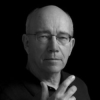Sam Abell

Sam Abell
Sam Abellis an American photographer known for his frequent publication of photographs in National Geographic. He first worked for National Geographic in 1967, and is one of the more overtly artistic photographers among his magazine peers. Sam Abell's style of photography is documentary in the sense that his major avenue, the National Geographic magazine, is a publication of record. However, his best work is known for its transcendent qualities, starting at the documentary level yet open to interpretation on an...
NationalityAmerican
ProfessionPhotographer
CountryUnited States of America
Aboriginal Australia is a tough place to work, rough and tough.
The best lesson I was given is that all of life teaches, especially if we have that expectation.
The unusual wins out over the usual.
I had luck, but I worked hard and I suffered. It's not just photography I'm talking about. It's about whatever dream you want it to be.
There's a great quote about Virginia Woolf, she had the same spiritual stake in her diaries as she had in her writing.
When I first went to 'National Geographic,' I thought I was the least qualified person to step through the doors. But because of my parents and the culture of continual learning they imposed on us, I later came to believe I was the most qualified person who ever worked there.
Actually, ambition won't get you that far. You'll shift gears. You'll see something that's shinier. But if you believe... then you're the long-distance runner.
...just like some people's instinct to photograph is triggered by vacation... assignments might be that to me and that's why I've built my life around assignments. That was the way to live the photographic life.
I have this awareness that the more dynamic the situation is, the more on guard I need to be that the dynamic isn't controlling the situation. I found that myself in the Galapagos. For the first time in my life I was around very exotic animals, colorful, beautiful, and immediately present, all around. Birds, turtles, iguanas, seals. I was being seduced by their exoticism, I was taking pictures.The pictures weren't well lit, there was no moment in play, there was no depth to the pictures. I was just gawking with my camera at something I'd never seen before.
The neatest part of this book I'm working on - to me - are the pictures that show the process... Because photographers... think things through and... it isn't luck, and it isn't random and it isn't accidental. It isn't.
My parents, grandmother and brother were teachers. My mother taught Latin and French and was the school librarian. My father taught geography and a popular class called Family Living, the precursor to Sociology, which he eventually taught. My grandmother was a beloved one-room school teacher at Knob School, near Sonora in Larue County, Ky.
My father taught me photography. It was his hobby, and we had a small darkroom in the fruit cellar of our basement. It was the kind of makeshift darkroom that was only dark at night.
Typically I see it with photographers who go to a place like India or Nepal, and everything's so colorful and exotic and they think, therefore, a picture's been taken.
I was known as a 35-mm photographer with a view-camera mentality.